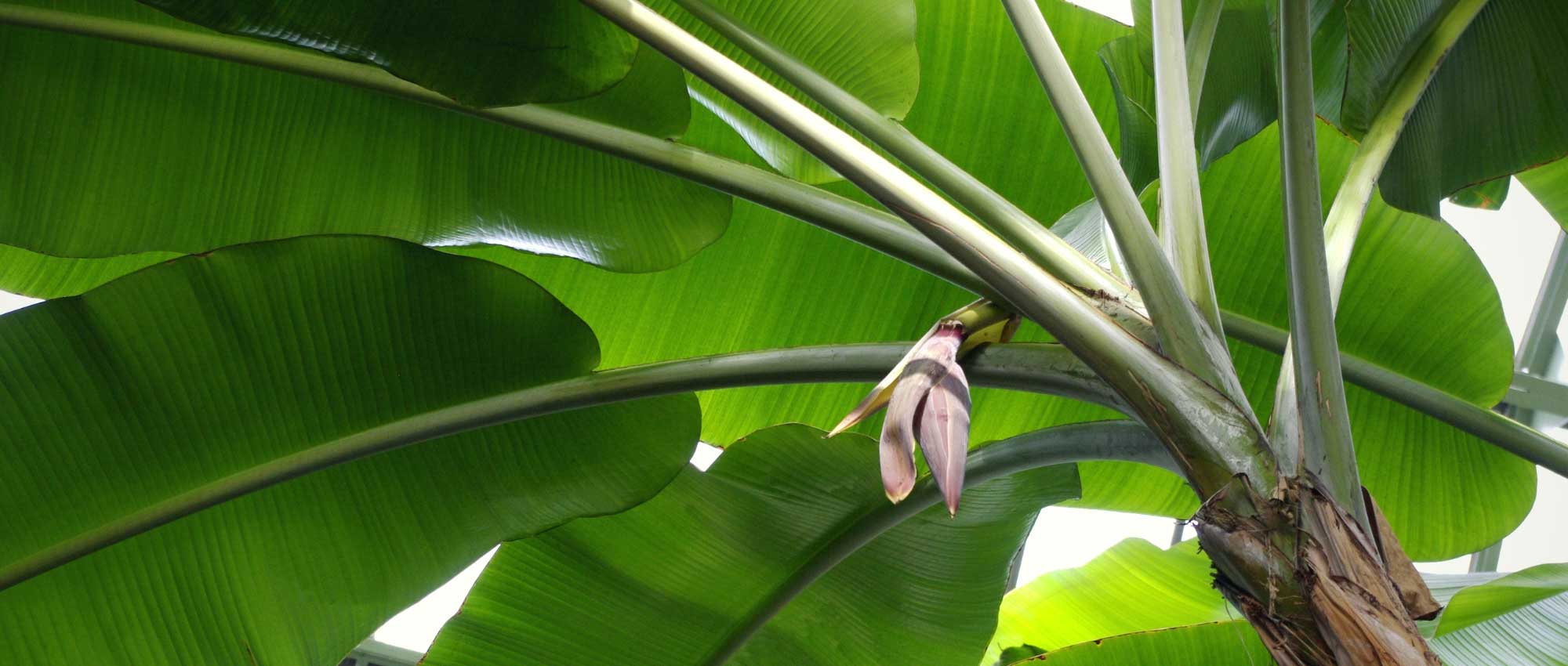
Banana plant: planting, cultivation and maintenance, in pot or in garden
Contents
Banana plants in a nutshell
- Banana plants have superb lush foliage, ample and light green in colour.
- They are vigorous plants that appreciate warmth and humidity, and their growth is very rapid.
- Some species have leaves marked with red-purple.
- Symbol of exoticism and tropical landscapes, the banana plant is the ultimate plant for a change of scenery.
- Some species are quite hardy and can be grown in temperate regions!
A word from our Expert
Banana plants impress us with their majestic silhouette and enormous leaves. Their presence in the garden immediately creates a lush and exotic, tropical atmosphere. Most of them are sensitive to cold and should therefore be grown in a greenhouse or indoors… but there are also hardy varieties, such as Musa basjoo, allowing you to enjoy a touch of exoticism in the garden, even in temperate regions. However, outdoors in our climates, there is little chance that you will be able to harvest bananas! In any case, ornamental banana plants are not grown for their fruits, which are often small and inedible, but for their foliage and exotic appearance. Hardy banana plants adapt well to outdoor planting in the ground (although they can also be placed in pots and brought indoors for winter), while tropical species are generally grown as houseplants.
The banana plant is a lush plant that primarily needs warmth and humidity. It thrives in a sunny spot sheltered from prevailing winds. Planting should be done when there is no longer a risk of frost, starting from mid-May. As for maintenance: protect it from the cold in winter, with several layers of winter fleece, or bring it under cover if it is in a pot. The banana plant requires significant watering and regular fertiliser applications. In general, banana plants are vigorous and grow very quickly. They are relatively easy to grow.
Description and Botany
Botanical data
- Latin name Musa sp.
- Family Musaceae
- Common name Banana plant
- Flowering July-August
- Height 1 to 5 m
- Exposure sun, partial shade
- Soil type rich, cool, even moist, draining
- Hardiness not very hardy, but some species tolerate temperatures below -10 °C
The banana plant is a large herbaceous perennial that takes on an arborescent silhouette and offers lush vegetation. It has enormous leaves of a beautiful light green colour! Banana plants comprise 70 species, which belong to the genus Musa. They primarily come from Southeast Asia, where they grow in undergrowth and forest edges. The banana plant thrives in warm, humid climates; it is therefore mainly cultivated in tropical regions… However, there are also species capable of adapting to cooler climates. This is the case, for example, of the Musa basjoo. Although it is called the “Japanese banana”, this species is native to China, where it grows up to 3,000 metres in altitude. This explains its good hardiness (it withstands temperatures down to -12 °C), making it the most widespread banana plant in gardens. Other species that are quite resistant to cold can also be found, such as Musella lasiocarpa (down to -10 °C). Banana plants can also be grown on verandas, in greenhouses, or indoors as houseplants. Tropical species do not like temperatures dropping below 10 °C.
The cultivation of banana plants is very ancient, as they are believed to be one of the first plants cultivated by humans. Buddhists already mentioned them in the 6th century BC. The cultivation of bananas arrived in Central America in the early 16th century but developed mainly in the 19th century. Bananas are now a staple food in many tropical regions. They are also one of the most consumed fruits in France. In addition to their culinary interest, bananas have excellent nutritional qualities and medicinal properties.
Banana plants (Musa sp.) have given their name to the family Musaceae, of which they represent almost all species (70 species out of 78). This family indeed includes only one other genus, Ensete, with only 8 species. Being very close, Ensete are also called banana plants. A third genus is sometimes considered: Musella (like Musella lasiocarpa).
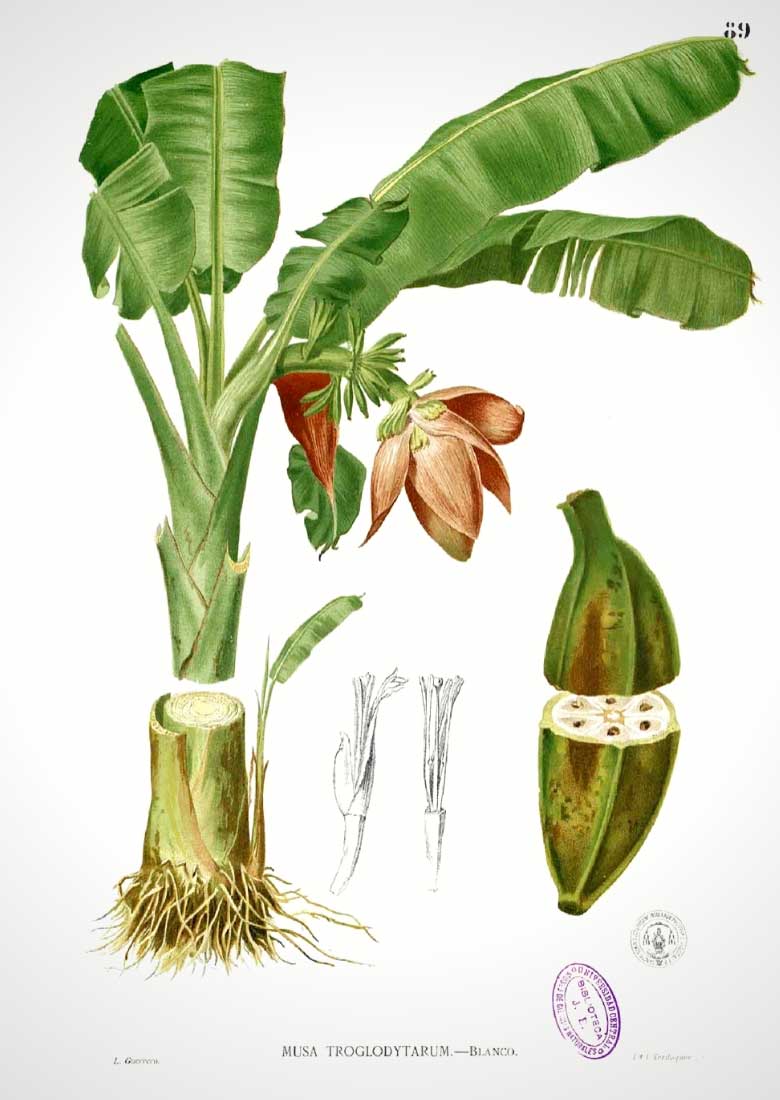
Musa troglodytarum: botanical illustration
The banana plant was named Musa by Linnaeus in honour of Antonio Musa, the physician of the Roman Emperor Augustus in the 1st century BC.
The Ensete ventricosum, or “Abyssinian banana plants”, are appreciated in gardens for their large green leaves with a red midrib, although they are quite not hardy. They are native to Africa.
Despite its imposing silhouette, the banana plant is not a tree. It is an herbaceous plant; it does not produce wood and does not form a true trunk… it is more accurate to consider it a giant herb than a tree! Banana plants are indeed monocotyledonous plants, like palms or grasses – and are therefore quite close to the “grasses” that form meadows and lawns. Monocotyledonous plants can take on an arborescent habit but are not true trees.
Banana plants thus possess a pseudo-trunk, which can be called a “stipe” (as in palms), at the top of which oblique or horizontal leaves unfold. This pseudo-trunk results simply from the stacking of the bases of the petioles (“stem” bearing a leaf), causing the plant to grow in height.
Banana plants are greedy and vigorous plants that grow very quickly. The Musa itinerans ‘Mekong Giant’, in particular, has an exceptional growth rate. The smallest banana plants measure one metre high, while the largest reach 5-6 metres. In their natural habitat, banana plants can exceed 10 m in height. Compact banana plants can easily be grown in containers.
It takes at least three years to see the banana plant flower. If you live in a cool region, there is less chance that it will flower, and especially that it will bear fruit. In Mediterranean regions, on the other hand, it is easier to have flowers.
The banana plant flowers in summer, around July-August. The flowering of Musella lasiocarpa lasts particularly long, often several months.
Banana plants then offer a large inflorescence, which is generally pendulous at the end of a long, thick peduncle, but can also be upright towards the sky.
The inflorescences are protected by large bracts. The flowers are small and long, thin tubes. They are yellow or cream-white and are more or less hidden by the bracts. The female flowers are aligned at the top of the inflorescence. These are the ones that will become bananas after pollination. The male flowers are found at the bottom and appear later.
In Musa basjoo, the bracts are brown and protect small yellowish flowers. However, in other species, the bracts take on very beautiful colours and give the inflorescence a decorative appearance. Thus, the red banana, Musa coccinea, bears superb bright red inflorescences, while Musa ornata offers a very beautiful pink flowering. The flowering of Musella lasiocarpa is very different from other species: the inflorescence is upright, bright yellow, with radiating bracts.
In their natural habitat, banana plants are pollinated, among other things, by bats!
The flowers of banana plants are edible! They are appreciated in Asia and can be consumed raw in salads or cooked. They have good nutritional values and medicinal properties.

The flowering of a banana plant / Detail of the flowers, gathered under a bract / The yellow flowering of Musella lasiocarpa (photo Stefan Bellini)
When they appear, the leaves are rolled up like a cigar and then unfold. The plant then bears very large and wide leaves, which can reach up to three metres long! The leaves are borne by a long petiole, which extends on the lamina into a thick, rigid midrib. On either side of this, secondary veins run parallel to each other, unbranched.
Being very large, the leaves are fragile and are easily torn by the wind. Some species, like Musella lasiocarpa, have smaller leaves that are less sensitive to the wind.
Ordinarily, the leaves are light to medium green. They have a very beautiful hue, taking on yellowish shades when under the sun. Ensete ventricosum ‘Maurelli’ stands out for its foliage marked with dark red, purplish hues. There are also banana plants with variegated white foliage. Musa ‘Siam Ruby’ has entirely red leaves!
At the end of the year, the leaves fall with the cold and the first frosts, but they will reappear in spring. Banana plants therefore exhibit a deciduous behaviour in regions with a temperate climate, while they retain their leaves all year round in warm regions or if grown indoors.
If it gets cold, the aerial parts may disappear. In the Japanese banana (Musa basjoo), the leaves die from -2 °C and the aerial parts (pseudo-trunks) disappear from -7 °C. However, the stump remains alive, and the plant will regrow from the base in spring. For less hardy banana plants, it is best to bring them indoors in winter and take them out in summer (plant them in a temporary summer bed or leave them in pots on a terrace). However, tropical species are usually grown as houseplants, at temperatures that remain above 10 °C.

Ensete ventricosum ‘Maurelii’ / Musa basjoo (photo David J. Stang) / The variegated foliage of Musa x paradisiaca ‘Ae Ae’ (photo Mokkie)
The banana plant is a suckering plant. It has a rhizome (underground stem), which produces offsets more or less distant from the stump. These can be taken to propagate the plant. Similarly, these offsets take over when the original plant dies (for example, after flowering or in cold conditions).
In a warm, humid climate, the flowers give way to bunches of bananas. Bananas are generally yellow, elongated, and curved. However, they can also take on surprising colours: green, pink, purple, or red… They are pink and fuzzy in Musa velutina!
The bananas we consume have no seeds. They are therefore sterile. The fruits are parthenocarpic, appearing without fertilisation. These banana plants are therefore propagated vegetatively. In other species, wild or cultivated as ornamental plants, bananas contain many seeds. Their fruits are not really edible. They are generally small, filled with seeds, and tasteless.
Banana plants are semelparous: each pseudo-trunk flowers only once. Banana plants die after flowering and fruiting, but produce offsets that replace them.

Bunches of bananas / A fruit from a wild banana plant, filled with seeds (photo Warut Roonguthai) / The pink bananas of Musa velutina (photo Hans Hillewaert)
Read also
Potted Banana tree: planting and careThe varieties
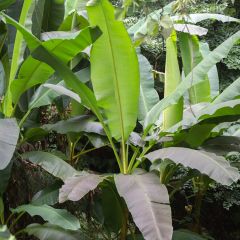
Musa basjoo - Hardy Banana
- Flowering time August, September
- Height at maturity 4,50 m
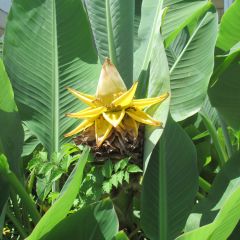
Musella lasiocarpa - Golden Lotus Banana
- Flowering time August to October
- Height at maturity 1,65 m
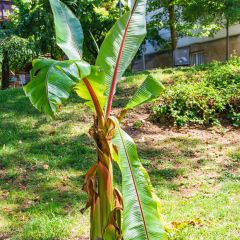
Ensete ventricosum - Ethiopian Banana seeds
- Flowering time July
- Height at maturity 3 m
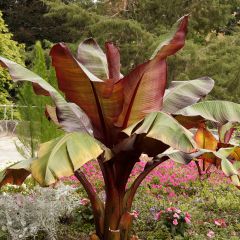
Ensete ventricosum Maurelii - Ethiopian Black Banana
- Height at maturity 3 m

Musa sikkimensis Red Tiger - Hardy Banana
- Flowering time August, September
- Height at maturity 2,50 m
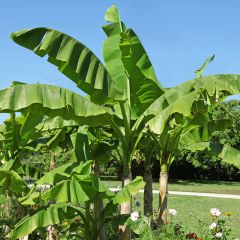
Musa basjoo Sakhalin - Hardy Banana
- Flowering time August, September
- Height at maturity 3 m
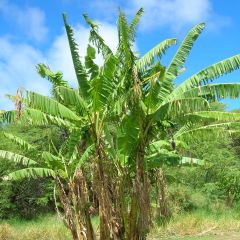
Musa itinerans var. xishuangbannaensis Mekong Giant - Hardy Banana
- Flowering time August, September
- Height at maturity 10 m
Discover other Musa - Banana tree
View all →Available in 3 sizes
Available in 1 sizes
Available in 2 sizes

Available in 1 sizes
Available in 1 sizes
Available in 2 sizes
Available in 1 sizes
Available in 1 sizes
Available in 2 sizes
Planting a banana plant, in a pot or in the garden
Where to Plant Banana Plants?
The banana plant requires warmth. It is best to plant it in full sun or partial shade but with significant brightness. However, if you are growing it in a greenhouse or conservatory, it is advisable to provide shade during the hottest hours to prevent the sun from scorching the leaves.
Choose a sheltered spot from the wind, protected by walls or other plants. The leaves of the banana plant are very large and long, with parallel veins, making them prone to tearing in the wind. The ideal situation is to plant banana plants against a south-facing wall: this way, they will benefit from a protected and warm location.
The banana plant is a greedy plant, it needs a substrate rich in organic matter and fertile. Provide it with compost or manure. If you are growing it in a pot, it will require fertiliser.
Although the banana plant enjoys cool to moist soils, it should still be planted in well-draining substrate. If water stagnates, it could suffocate or rot the root system. We suggest installing a drainage layer at the bottom of the planting hole.
The banana plant creates a superb atmosphere when placed by a water feature, pond, or swimming pool, for example, alongside palms, Tetrapanax, or Gunneras… Guaranteed change of scenery!
Remember that the banana plant is a large plant, so ensure you place it in a location where it has enough space to develop properly and extend its immense foliage (the leaves can measure up to three metres long!).
It is preferable to plant frost-sensitive species in pots. This way, you can easily shelter your banana plant from the cold by bringing it under a conservatory and taking it outside for the summer. Banana plants from tropical regions are more suited to indoor cultivation or under a conservatory all year round. In this case, avoid placing them in direct sunlight, for example, behind a south-facing window, as this could scorch their foliage. Provide shade if necessary during the hottest hours of the afternoon.
When to Plant?
If you are growing your banana plant in the ground, wait until the end of spring to plant it, when there is no longer a risk of frost, that is, from mid-May. Indeed, temperatures need to warm up before planting. In a warm climate, or for indoor cultivation, it is possible to plant it all year round.
How to Plant a Banana Plant?
In the Ground:
- Start by soaking the root ball in a basin filled with water. This will rehydrate the root system and facilitate the plant’s recovery.
- Dig a planting hole two to three times the size of the root ball. Dig deep enough to loosen and aerate the soil well.
- Place a drainage layer at the bottom (gravel, coarse sand, pumice, broken pot shards…). This will prevent water from stagnating and rotting the roots.
- Fill with garden soil mixed with well-decomposed compost and potting soil, possibly with a bit of coarse sand for drainage.
- Remove the banana plant from its pot and place it in the planting hole.
- Replace the soil around the stump, then firm it down to ensure good contact between the soil and the roots.
- Water abundantly after planting.
You can cover the soil with mulch at the base of your banana plant.
In a Pot:
- Take a large pot or container.
- Place a drainage layer at the bottom: gravel, broken pot shards, clay balls…
- Fill with a mix of good horticultural potting soil, garden soil, and well-decomposed compost, with a bit of coarse sand for drainage.
- Place the plant and add substrate around it, then firm it down.
- Water abundantly.
Continue to water several times a week after planting.
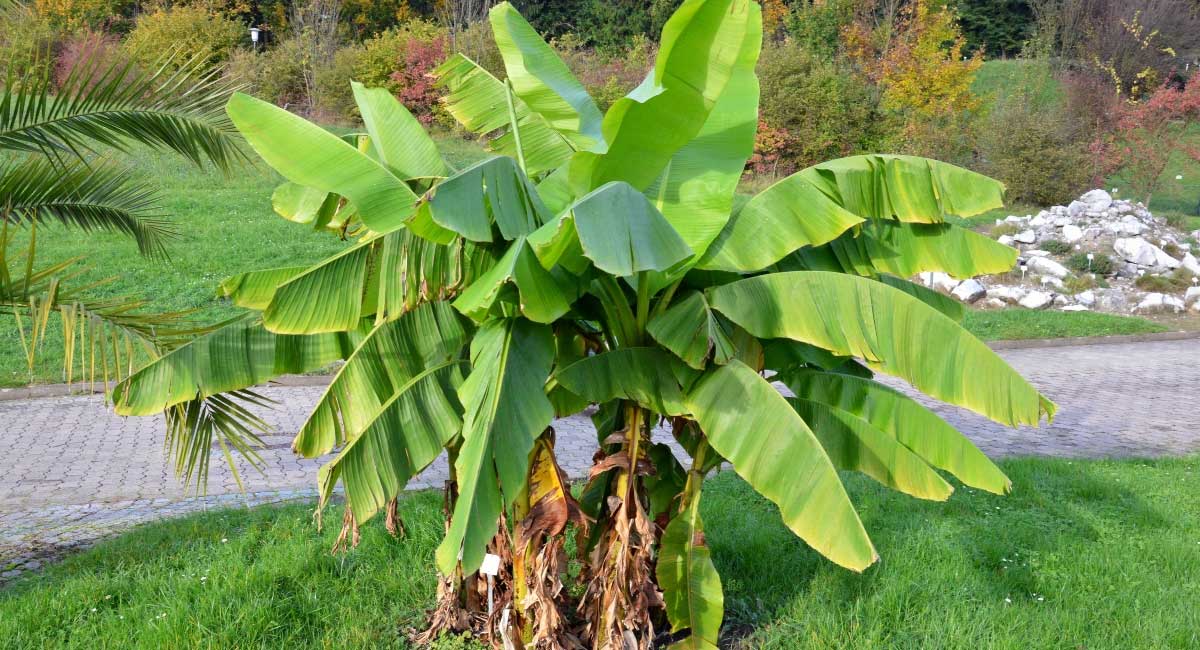
Musa basjoo (photo: Illustratedjc)
Read also
How to propagate banana plants?Caring for banana plants
The banana plant is a greedy plant, both in terms of water and fertiliser. In pots, apply liquid fertiliser every 15 days. In the ground, do not hesitate to add compost or manure. It will also need to be watered frequently to keep the substrate relatively moist. We recommend installing a mulch to prevent the water from evaporating too quickly. Water and fertiliser needs are significant throughout the growing season, from spring to autumn. Reduce these inputs in winter to avoid rotting the root system.
Tropical species, grown as houseplants, are sensitive to cold and need temperatures to remain above 10 °C. Similarly, for indoor cultivation, we suggest regularly misting the leaves of your banana plants. The air in homes and apartments is often too dry for them. You can also place clay balls or gravel in a saucer, add water, and set the pot on top of the gravel. As the water evaporates, it will create a microclimate with a high humidity level.
We advise repotting your banana plant every two years, at the beginning of spring. Take a slightly larger pot each time. You can also perform surface treatments from time to time: remove some potting soil from the surface by scraping the substrate a few centimetres down, then replace it with fresh potting soil.
Banana plants can be affected by a few pests, especially when grown indoors or in a greenhouse. You may notice the appearance of mealybugs: small oval insects with a powdery white appearance. To get rid of them, you can use a mixture of water, black soap, vegetable oil, and methylated spirits, or, if the infestation is less severe, a simple cloth soaked in soapy water. Be also cautious of red spider mites. You can easily eliminate them by spraying water on the leaves. Finally, banana plants can be attacked by aphids, and sometimes the leaves of young plants are chewed by slugs and snails.
Banana plants are rarely affected by diseases. It is mainly important to be cautious of excess moisture in winter, which could cause the roots to rot.
→ Learn more about the diseases and pests of banana plants in our advice sheet.
Protecting banana plants from the cold:
Although some species can withstand temperatures below -10 °C, it is better to protect them from the cold. This will help the plant retain its aerial parts (pseudo-trunk). In climates where winters are cool, or for the cultivation of certain species like Ensete ventricosum, winter protection is essential.
You can protect your banana plant by cutting off its lowest leaves, then installing a mesh around the pseudo-trunk and filling it with a thick layer of dead leaves or straw to insulate it from the cold. You can remove this protection in spring.
If you are growing it in a pot: take the banana plant outside in spring when the risk of frost has passed. Bring it back in autumn. You can leave it outside from late May to September.
Also, check out our video tips for wintering banana plants:
Multiplication
The best technique for multiplying banana plants is to take the suckers that appear near the main stump, after ensuring they have roots. They can also be multiplied by sowing.
Taking Suckers
The banana plant produces suckers near the stump, which you can take by separating them from the original plant. Do this in spring, around May.
- Identify a banana plant with suckers that are at least 20 cm tall.
- Take one of these suckers by separating it from the original plant. Carefully dig to expose the root system without damaging it. Find the point where the sucker is attached to the mother plant, and cut this part, if possible using a sharp, disinfected knife.
- We recommend removing its old leaves, keeping only the younger ones.
- Replant it immediately, in a pot or in the ground, in a rich, well-draining substrate.
- Water generously.
If you have planted in a pot, place it in a warm spot, in partial shade.
Ensure that the substrate remains moist until the sucker resumes its growth.
→ Also check out our tutorial on banana plant cuttings and Ingrid’s advice in Dividing the banana plant: how to separate the suckers?.
Sowing
- Soak the seeds in warm water for at least 24 hours. Indeed, banana seeds are surrounded by a hard coating; soaking them helps to soften it and break dormancy.
- Prepare a pot by filling it with special sowing compost, to which you can add a bit of sand.
- Sow the seeds.
- Cover them with a few centimetres of substrate.
- Water.
- Place the pot at a temperature of around 25 °C. It is preferable for daytime temperatures to be higher than nighttime temperatures.
Germination can occur within two weeks after sowing, but it can sometimes take much longer, requiring several months. Be patient.
Ensure that the substrate remains slightly moist until germination.
Association
Obviously, the banana plant is the ideal choice for exotic gardens! It pairs very well with other plants featuring enormous foliage: Gunnera, Tetrapanax, Hosta, arborescent ferns, palms, castor beans… You will create a jungle garden, composed of lush vegetation. You can also combine your banana plants with Albizzia, Yuccas, and possibly some bamboos for their verticality and graphic appeal. Enjoy the colourful foliage of certain grasses, such as Hakonechloa, Carex comans, Imperata cylindrica ‘Red Baron’… For a consistently wild and lush appearance, don’t hesitate to install some lianas: hops, akebia, passionflower, bignonia, wisteria…
In terms of flowering, favour yellow, orange, and red shades: cannas, hedychiums, crocosmias, strelitzia, dahlias… Also take advantage of the unique flowering of Eucomis or the very elegant flowers of Crinum.
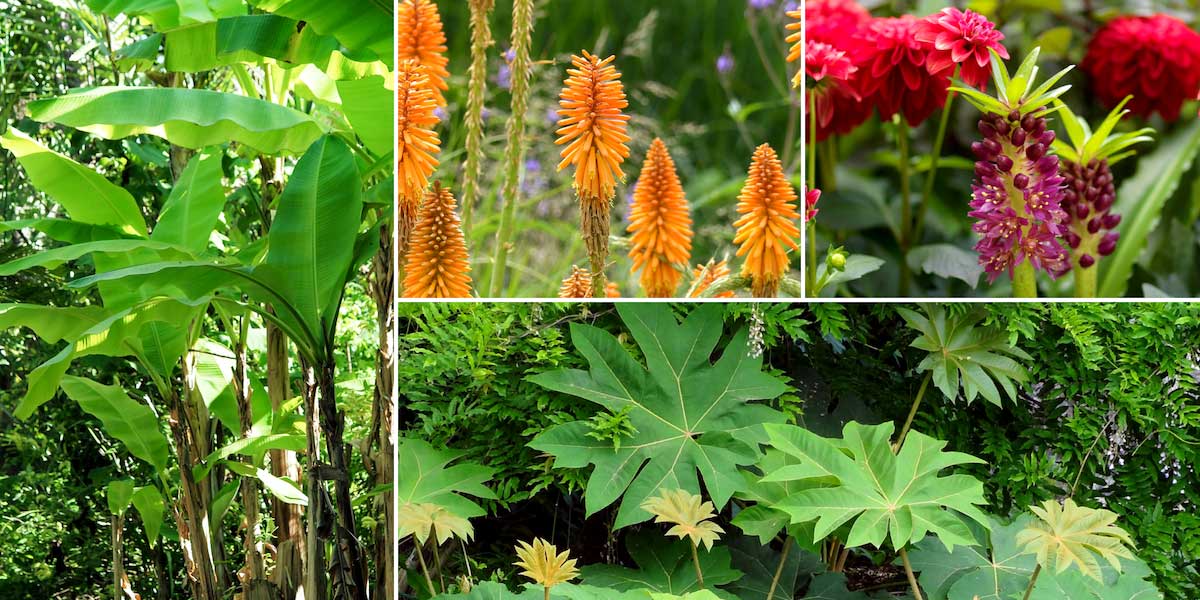
The banana plant is ideal in exotic-style gardens! Musa basjoo, Kniphofia ‘Fiery Fred’, Eucomis ‘Sparkling Burgundy’ and dahlias (photo Steven Bemelman – iBulb) and Tetrapanax papyrifera ‘Rex’
You can pair banana plants with other exotic or unusual fruit trees, which are quite rare: Persimmon, Feijoa, Goji, Kumquat…
Don’t hesitate to place banana plants by the edge of a pond or pool, alongside other plants that will create a paradisiacal look: palms, yuccas, phormium, arborescent ferns…! These plants will give you the impression of being on holiday, ensuring a complete change of scenery! Remember to choose a warm spot protected from the wind.
You can integrate the banana plant into a summer, seasonal bed by planting it after the last frosts and digging it up in autumn to place it under cover. Create a summer bed, with warm tones, using plants that you will install temporarily: begonias, crocosmias, decorative-leaved ipomoeas, nasturtiums, dahlias, lantana, Cosmos atrosanguineus, zinnia… In the same vein, you can place the banana plant with other tender plants that need to be brought under a greenhouse or veranda in winter (citrus trees, strelitzia, etc.)
→ Discover more ideas for pairing with the banana plant in our advice sheet.
Did you know?
- Uses
The pseudo-trunks and leaves of the banana plant contain fibres that can be used to make items such as cords, paper pulp, and textiles. Engineers have even developed an eco-friendly and highly decorative coating made from these fibres. The banana plant Musa textilis produces Manila hemp, which is notably used for making ropes. The leaves of the banana plant can also be used for roofing!
Banana flowers are edible! They can be added raw to salads or cooked.
The leaves are sometimes used to serve dishes, providing a very decorative effect, or to make parcels for cooking rice or fish, for example.
The roots and stipe of the Abyssinian banana, Ensete ventricosum, yield a starchy food that is consumed particularly in Ethiopia.
In East Africa (Burundi, Rwanda, Congo…), banana beer, known as Kasiksi, is also made.
Useful resources
- Discover our range of banana trees
- Our video tips – Wintering banana trees
- To accompany banana trees in the garden, discover other plants with an exotic style
- An article by Ingrid on our blog – 10 exotic and hardy plants for a Jungle garden
- Our advice sheets: Which banana tree to plant according to your region?; 5 cold-resistant banana trees
- Learn more about diseases and pests of banana trees
- Our advice sheet: How to grow a banana tree in the ground.
- Our tutorial: How to prune a banana tree?
- You will learn everything about banana trees in The banana tree in 10 questions/answers!
Frequently asked questions
-
Will my banana plant be able to bear fruit?
Although some species are hardy, the banana plant requires a very mild climate to flower, produce fruit, and for the fruit to reach ripeness. Outdoors in our climates, there is little chance of it fruiting. Under a greenhouse, it is possible. In any case, the bananas from ornamental varieties are not very interesting to consume! For fruit, it is preferable to grow Musa acuminata ‘Dwarf Cavendish’... Or Musa ‘Helen’s Hybrid’, a banana plant that is both hardy (-10°C) and edible, producing small bananas with a sweet taste and containing seeds.
-
The leaves of my banana plant are turning yellow. Why?
If this occurs in autumn and the plant is outdoors, it is normal. The cold naturally causes the foliage to yellow and dry out. Cut the leaves and reduce watering. Otherwise, if the leaves are yellow and soft, it is likely that the roots are rotting due to excess moisture in winter. Stop watering; if your banana plant is in a pot, remove the saucer underneath and place the plant in a warm spot. The appearance of yellow spots on the foliage is often caused by excessive exposure to sunlight. If you are growing it in a greenhouse, shade the leaves during the hottest hours. Finally, yellowing of the foliage may be due to a deficiency in mineral elements. In this case, apply fertiliser.
-
Why isn't my banana plant flowering?
You need to wait for the stipe to be at least three years old for the banana plant to flower. Additionally, the banana plant requires warmth. It flowers much more easily when grown in a greenhouse, benefiting from high temperatures and good light. If you cultivate it outdoors in a climate with cold winters, there is little chance that your banana plant will flower.
-
My banana plant seems dead...
The stipe may freeze during a cold winter, but if the plant is hardy enough, it will regrow from the stump in spring. You should then cut the stipe at soil level. Similarly, the banana plant naturally dies after flowering... but generally, the offsets come to take over and replace it!
- Subscribe!
- Contents
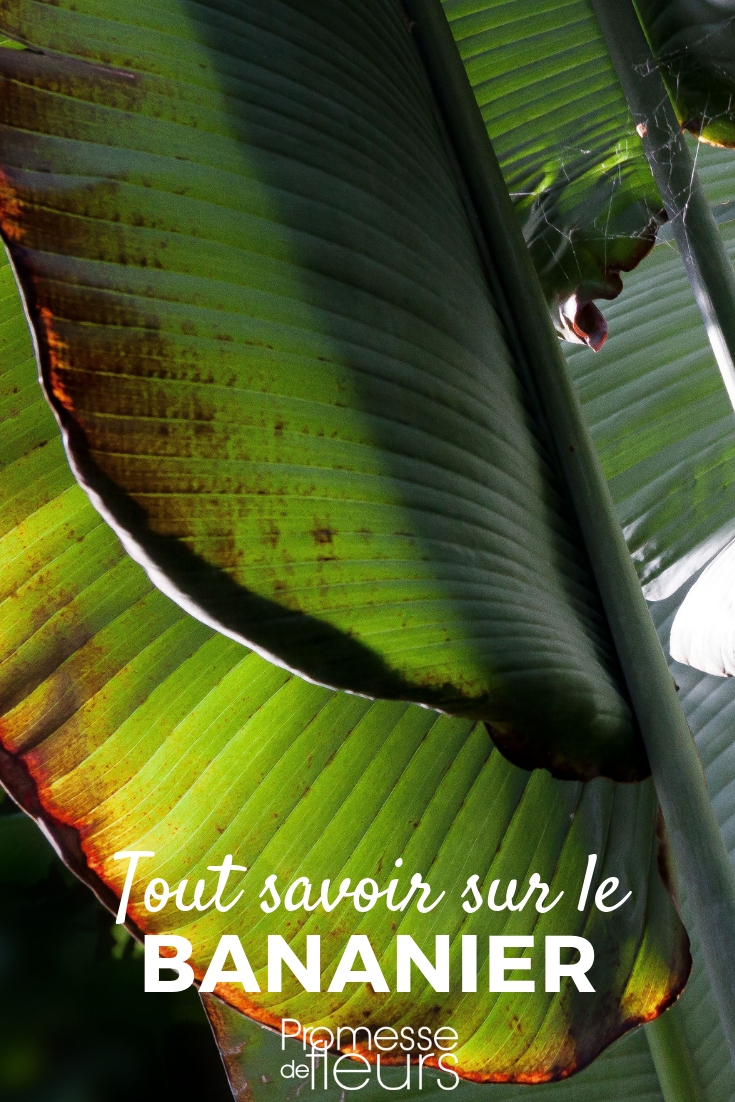
































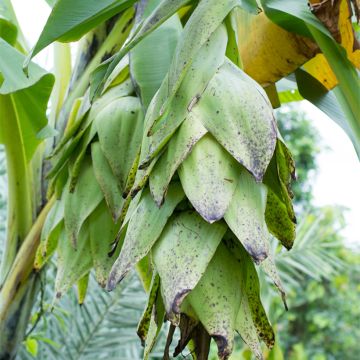

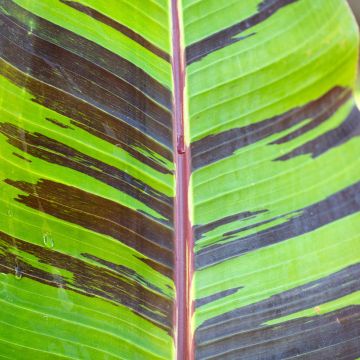
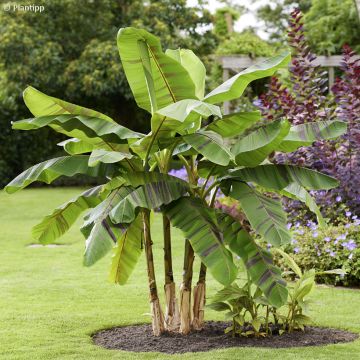
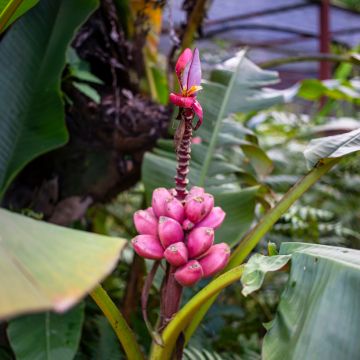
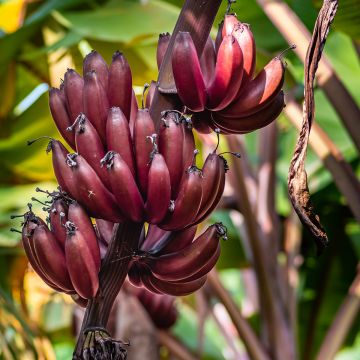

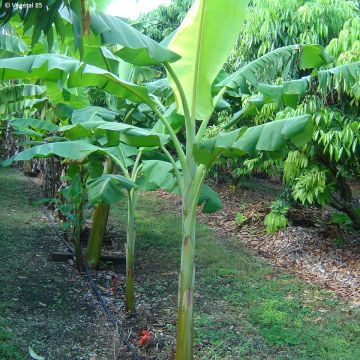
Comments